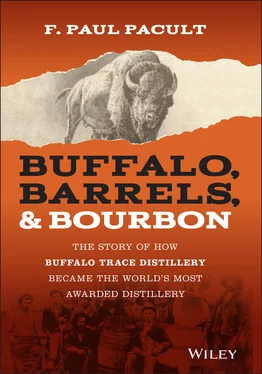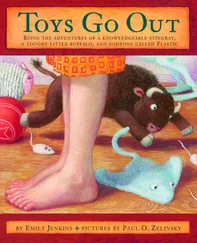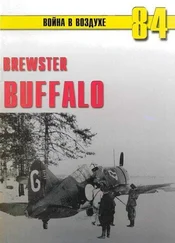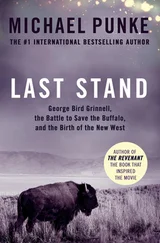In terms of individual size the North American buffalo is an imposing, sinewy yet compact biological machine. Females average from 700 to 1,000 pounds, stand five feet at the shoulder and are six to seven feet from nose to tail while males can tip the scales at 1,800 to 2,000 pounds, stand six feet at the shoulder and span up to nine feet in length. In their innate “fight or flight” genetic programming, the slightest disturbance while they are at rest or grazing can, in an instant, set an entire herd into unpredictable, helter-skelter motion from zero to 30 miles per hour. This hair-trigger reflex is why Native American hunters, who regarded the buffalo as a sacred being, used so much caution, stealth, and concealing costumes when in the hunt. Their elaborate precautions taught the Euro-American longhunters and their successors about the necessity for extreme safeguard measures when dealing with the skittish buffaloes.
The Euro-American explorers encountered buffalo not only in small groups of 20 to 50 but also in vast herds in the tens of thousands, stretching across middle America's fertile prairies, which were carpeted with swaying short and tall grasses. The largest reported gatherings ranged from 100 to 500,000 buffalo. As the massive herds of buffalo trotted in migration mode, the ground underfoot quaked in rolling temblors and the air hummed with the sound of hooved thunder and guttural murmurs. The pong of hide, urine, and dung stung the eyes and clouds of billowing dust clogged the nostrils. Witnessing wild buffalo searching for sustenance in such staggering numbers proved such an awe-inspiring spectacle that it inspired the more literate early adventurers to connect pen to notebook. “The amazing herds of buffaloes, which resort thither, by their size and number, fill the traveller with amazement and terrors, especially when he beholds the prodigious roads they have made from all quarters as if leading to some populous city,” described Kentucky surveyor, mapmaker, historian, and pioneer John Filson in 1784. 7 Twenty-one years later on August 29, 1806, William Clark wrote in the journal of his historic expedition to the Pacific Ocean with Meriwether Lewis about the spectacle of the buffalo population, estimated then to be in the range of at least 30 million, and by some estimates possibly 60 million, across the continent. Of the wonder he felt, Clark wrote, “I assended to the high Country and from an eminance I had a view of the plains for a great distance. From this eminance I had a view of a greater number of buffalow than I had ever Seen before at one time. I must have Seen near 20,000 of those animals feeding on this plain.” 8
The buffalo herds were perpetually in motion. They thrived by grazing on the nutrient-rich, flat-as-a-tabletop, grassy plains, and sheltered in woodland regions that spanned from northwestern Canada south through the heartland prairies to northern Mexico, as well as southeast to the hardwood forests of the Appalachian mountain chain. The immense range that sustained the buffalo population covered more than one-third of the North American continent in the late 1500s. Buffalo roamed unchallenged throughout this vast tract of North America, trampling and sculpting the terrain and flora by the sheer enormity of their numbers and the incessant pounding of millions of hooves. Their seasonal migrations traveled along ancient pathways that had been carved into the landscape over millennia. Many of the buffalo trails, or traces , were in some locations hundreds of feet wide and up to four feet deep. Their battered traces in which the dirt was pulverized to an almost stone-like hardness were connected, like the blue highways on a present-day roadmap, by specific locations and topographical intersections that provided natural mineral deposits, such as sulfur, magnesium, calcium, phosphorus, potassium, and sodium chloride. The most important mineral deposit of all to the herds, more vital than all the other minerals, was sodium chloride (NaCl), also known as salt.
Salt is a key life-sustaining nutrient for all of the Earth's marine and terrestrial mammals. Sodium chloride is vital to the daily maintenance of muscle and nerve function, as well as fluid regulation. When mammals, including humans, sweat and urinate, they lose sodium. Mammals that reside in the planet's oceans, like dolphins, whales, otters, seals, walruses, and porpoises, are surrounded by salt, so their replenishment of sodium is easily met. Land-based mammals, however, must by necessity search for salt. This is especially true of the large, four-legged mammals that inhabit the continental landmasses.
Early visitors in the Ohio River Valley soon learned that the resting spots of mammal herds connected by traces served as roadway markers for their constant roaming in search of edible vegetation, salt, and fresh water. One observant geographer, Gilbert Imlay, described in the 1790s one of these mineral-laden stations, scribbling, “A salt spring is called a ‘Lick’ from the earth about them being furrowed out in a most curious manner by the buffalo and deer, which lick the earth on account of the saline particles with which it is impregnated.” 9 Another eyewitness account from the late 1790s whose author remains unknown depicted the effect of groups of buffaloes, writing, “The vast space of land around the salt springs desolated as by a ravaging enemy and the hills reduced to plains by the pawing of their feet. I have heard a hunter assert that he saw about a thousand buffaloes at the Blue Licks in Kentucky at one time.”
Prior to the invasion of travelers from the British colonies to northern Kentucky via avenues like the Wilderness Trail, the Cumberland Gap, and the Ohio River, native tribes utilized the roads bulldozed by buffalo herds as trade, warring, and hunting routes. An account from one of Reverend James Smith's trio of journals from 1783, 1795, and 1797 describing his travels through northern Kentucky's Bluegrass identifies one of the most famous buffalo traces, named Atlanant-o-wamiowee by the Shawnees. “We left the lick [probably Lower Blue Lick] and pursued our journey to Lexington following one of the old buffalo roads, which I suppose was generally 200 feet wide.” 10
From British Indian agent George Croghan's journals, dated from 1750 to 1765, came these observations, “We went to the great lick … On our way we passed through a fine timbered clear wood; we came into a large road which the buffaloes have beaten, spacious enough for two wagons to go abreast, and leading straight to the lick.” 11 Tennessee historian and lawyer Edward Albright wrote later in the late nineteenth century, “To the licks in the region … came at regular intervals the animals from all over a large territory, and these in their journeys to and fro formed beaten paths or trails, all centering in this locality like the spokes of a wheel … all traces led to central licks … Hunters, both Indian and white, roaming at will through the forests came upon these narrow paths, and turning about threaded them together.” 12
As a result of these and other accounts, names were bestowed on salt licks to identify their locations: French Lick, Big Lick, Licking Creek, White Lick, Big Bone Lick, Lower Blue Lick, Drennan's Lick, Knob Lick, May's Lick. The network of buffalo traces, connected by mineral salt licks, was the American heartland's first super-highway system. It provided a reliable web of terrestrial arteries that guided many of the bands of eastern colonists who yearned for the wider spaces, more fertile lands, and more abundant hunting grounds that lay west of the Appalachian Mountains. Some traces were busier than others, due mostly to their advantageous crossings at significant rivers and streams or their proximity to major salt deposits. As homesteaders with building and farming skills followed the explorers and surveyors in the last quarter of the 1700s, villages, merchant outposts, inns, and way stations mushroomed along traces in northern Kentucky, northern Tennessee, southern Ohio, and southern Indiana.
Читать дальше












